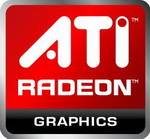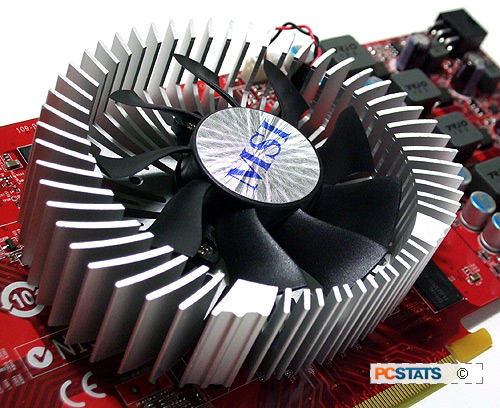 The
AMD Radeon HD 4830 GPU is based almost entirely on the same
technology found in the Radeon HD 4850 and Radeon HD4870, which is to say they're all derived from the same RV770 graphics processing unit (GPU).
The
AMD Radeon HD 4830 GPU is based almost entirely on the same
technology found in the Radeon HD 4850 and Radeon HD4870, which is to say they're all derived from the same RV770 graphics processing unit (GPU).
The
GPU for the Radeon HD 4830 has been code named the
'RV770LE', and like almost all GPUs of one family is most likely
binned from the same silicon as its more expensive brothers. The Radeon HD 48XX-series all share common
characteristics that help confirm this, like a 256 mm^2 die size with 965 million
transistors, built on the 55nm process.
The biggest difference between
the capabilities of the RV770LE and RV770 GPU are its 640 stream
processors, a reduction from the 800 available in the latter. Two of the ten Single
Instruction Multiple Data (SIMD) units are disabled on the Radeon
HD 4830's GPU, so while cut from the same cloth
each GPU has slightly different capabilities. In essence though, the Radeon HD
4830 is pretty much the same GPU as the Radeon HD 4850 and Radeon HD 4870, with
a few parts of the GPU disabled so that AMD can turn nearly-functional RV770
GPUs into fully functional RV770LEs.
Aside from the minor changes to architecture, the major
difference between the Radeon HD 4830 and its more expensive siblings are clock
speeds. The AMD Radeon HD 4830 runs at 575MHz core clock speed, versus the
625MHz and the 750MHz clock speeds for the HD 4850 and HD 4870 models respectively Both the
Radeon HD 4830 and the Radeon HD 4850 use GDDR3 memory, with 1800MHz and 1986MHz
effective speeds, while the Radeon HD 4870 is equipped with 3600MHz GDDR5
memory.
MSI's R4830-T2D512-OC videocard ships with a core clock speed bumped up 10MHz to 585MHz, while its
memory speed remains at 1800MHz. This is a relatively minor core speed increase, especially
given the overclocking capability of the RV770/RV770LE GPU as
we're about to show you....
Heat and Noise Observations
As mentioned above, the MSI R4830 videocard makes an audible, but
not unpleasant amount of noise when the fan is at full speed. It's about on par with the noise levels of the stock Intel socket 775 heatsink at medium speeds. When idling, the fan noise is quiet enough that it can't be heard over the background system noise and the ventilation system in the PCSTATS labs.

The MSI R4830 GPU stays pretty cool, even under load. With the GPU stressed temperatures still stayed around 40C, while idle temperatures were only a few degrees above room temperature - with stock thermal levels this low, this videocard could be an excellent overclocker, but we'll get to that in a minute.
Videocard Power Consumption
Measurements
MSI's R4830-T2D512-OC uses a single 6-pin PCI Express power connector in addition
to the power it draws from the x16 PCI Express slot. This is in line with its
position as a mid-range videocard since it doesn't require users to shell out
for more expensive power supplies with 8-pin PCI express connectors. This
videocard also features a novel "4 +1 power phase system", which supplies four
phases of power to the GPU while leaving a dedicated power phase for the
videocards memory. Apparently this helps overall system stability and
overclocking. Let's take a look at how much power the MSI R4830 draws in a
typical computer system.
Here's how the MSI R4830 videocard stacks up in real
life against a couple different cards. We have no way of directly measuring
video card power draw, so PCSTATS measures the total PC system power draw and
compares that in 3D loaded (max value recorded in 3DMark06) and idle states (at
Windows desktop). The power supply used in each test is an A-PFC compliant PC Power and
Cooling 750W model.
 Videocard Power Consumption (Total System
Power Draw) Videocard Power Consumption (Total System
Power Draw) |
| Idle at Desktop |
Watts |
Ranking |
| Palit HD4870 X2 2GB |
177 |
   |
| Asus EAH3870 X2 1GB
TOP/G/3DHTI/1G/A |
153 |
   |
| Asus EAH3870 X2 1GB TOP/G/3DHTI/1G/A
(Crossfire) |
222 |
   |
| MSI R3870X2-T2D1G-OC |
165 |
   |
| Diamond Viper Radeon HD 2900XT
CrossFire |
195 |
   |
| Asus EAH4850 HTDI/512M |
120 |
   |
 MSI R4830-T2D512-OC (Radeon 4830) MSI R4830-T2D512-OC (Radeon 4830) |
108 |
   |
| Asus EAX1900XTX 2DHTV/512M/A |
160 |
   |
| Asus EAX1950PRO/HTDP/256M/A |
150 |
   |
| nVidia Geforce
9600GTs in SLI |
166 |
   |
| Asus EN9600GT
Top/HTDI/512M |
152 |
   |
| Palit Geforce
9600GT 512 |
151 |
   |
| MSI
NX8800GTX-T2D768E |
196 |
   |
| MSI
NX7950GX2-T2D1GE |
183 |
   |
| MSI
NX7900GTX-T2D512E |
165 |
   |
| Gigabyte
GV-NX76T256D-RH |
140 |
   |
| 3D Loaded: |
Watts |
Ranking |
| Palit HD4870 X2
2GB |
421 |
   |
| Asus EAH3870 X2
1GB TOP/G/3DHTI/1G/A |
390 |
   |
| Asus EAH3870 X2
1GB TOP/G/3DHTI/1G/A (Crossfire) |
610 |
   |
| MSI
R3870X2-T2D1G-OC |
330 |
   |
| Diamond Viper
Radeon HD 2900XT CrossFire |
549 |
   |
| Asus EAH4850
HTDI/512M |
202 |
   |
 MSI
R4830-T2D512-OC (Radeon 4830) MSI
R4830-T2D512-OC (Radeon 4830) |
177 |
   |
| Asus EAX1900XTX
2DHTV/512M/A |
333 |
   |
| Asus
EAX1950PRO/HTDP/256M/A |
252 |
   |
| nVidia Geforce
9600GTs in SLI |
313 |
   |
| Asus EN9600GT
Top/HTDI/512M |
220 |
   |
| Palit Geforce
9600GT 512 |
221 |
   |
| MSI
NX8800GTX-T2D768E |
345 |
   |
| MSI
NX7950GX2-T2D1GE |
315 |
   |
| MSI
NX7900GTX-T2D512E |
277 |
   |
| Gigabyte
GV-NX76T256D-RH |
213 |
   |
| (OC) 3D Loaded: |
Watts |
Ranking |
| Palit HD4870 X2
2GB |
426 |
   |
| Asus EAH3870 X2
1GB TOP/G/3DHTI/1G/A (Crossfire) |
630 |
   |
| MSI
R3870X2-T2D1G-OC |
339 |
   |
| Asus EAH4850
HTDI/512M |
231 |
   |
 MSI
R4830-T2D512-OC (Radeon 4830) MSI
R4830-T2D512-OC (Radeon 4830) |
183 |
   | |
[*This figure represents total
system power consumption in Watts, either with the system at idle, or the peak
value recorded while running 3DMark06.]
The MSI Radeon HD 4830 videocard naturally draws less
power than the Radeon HD 4850-series, the previous power-saving king. Drawing
just 177W while under heavy GPU load is a refreshing change! Overclocking boosts
that value moderately, to 183W. In comparison, the Radeon HD 4850 runs at over
230W when stressed.
PCSTATS overclocking test results are up next! Are you
ready for a 20% overclock?
